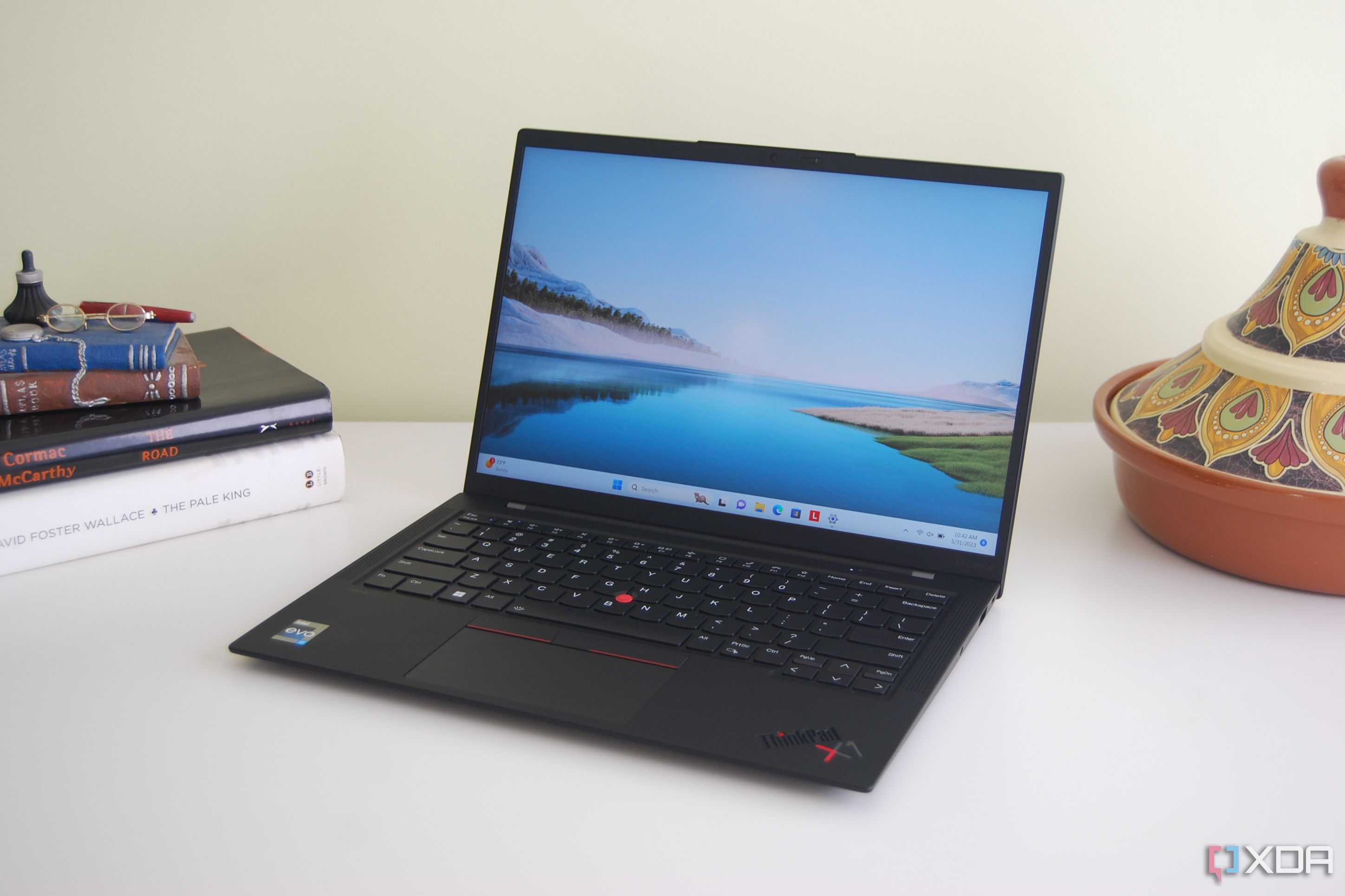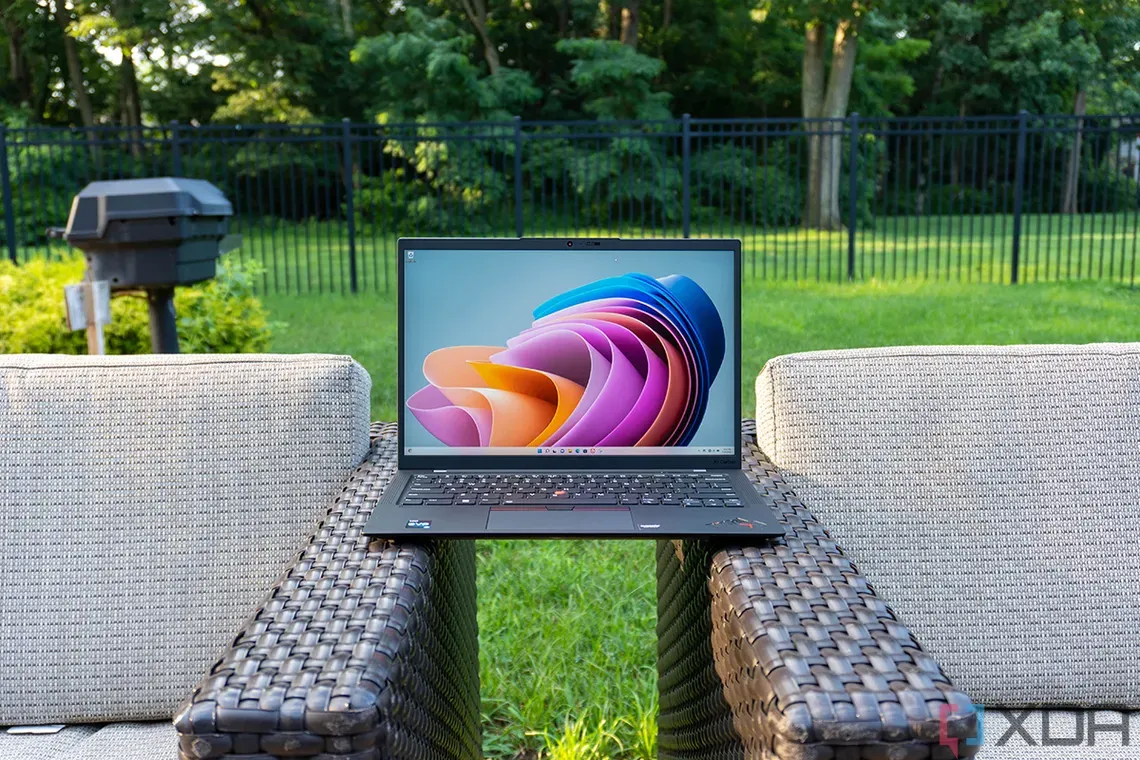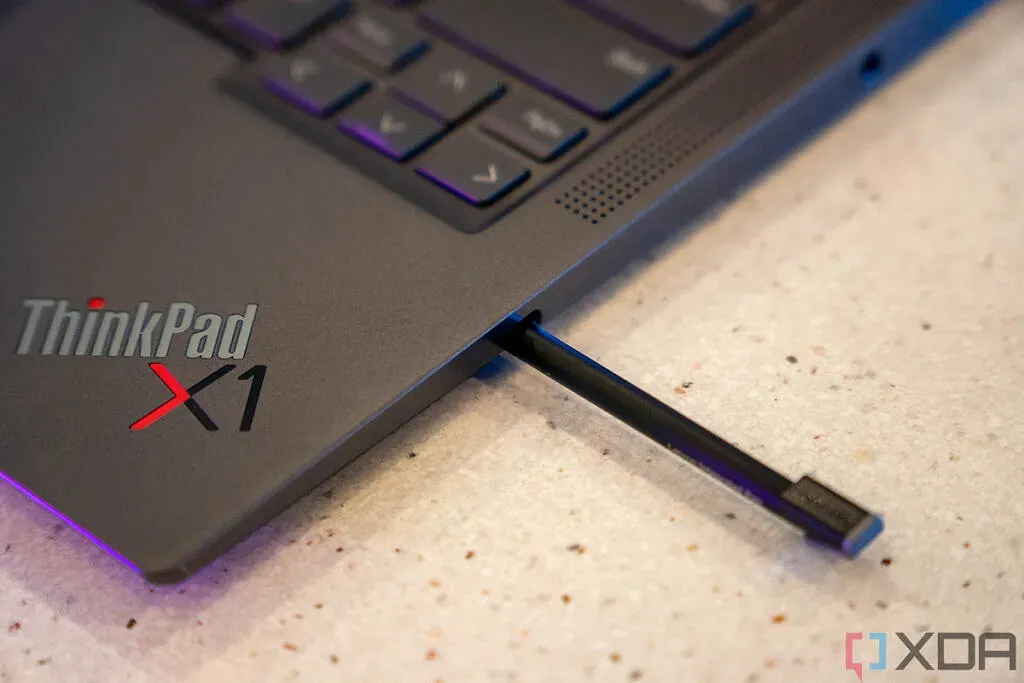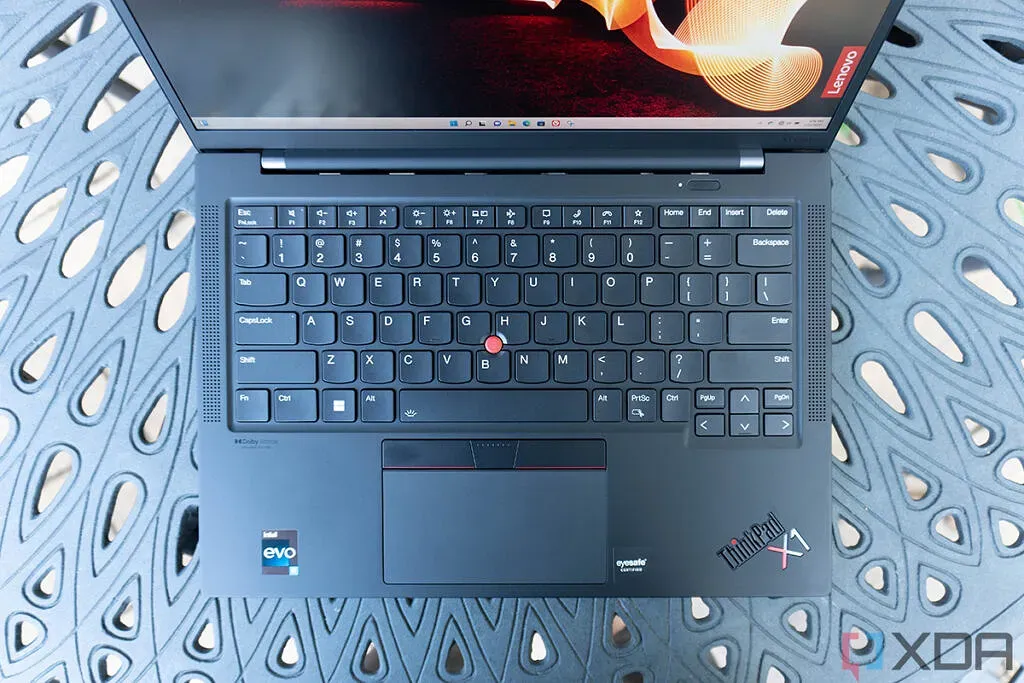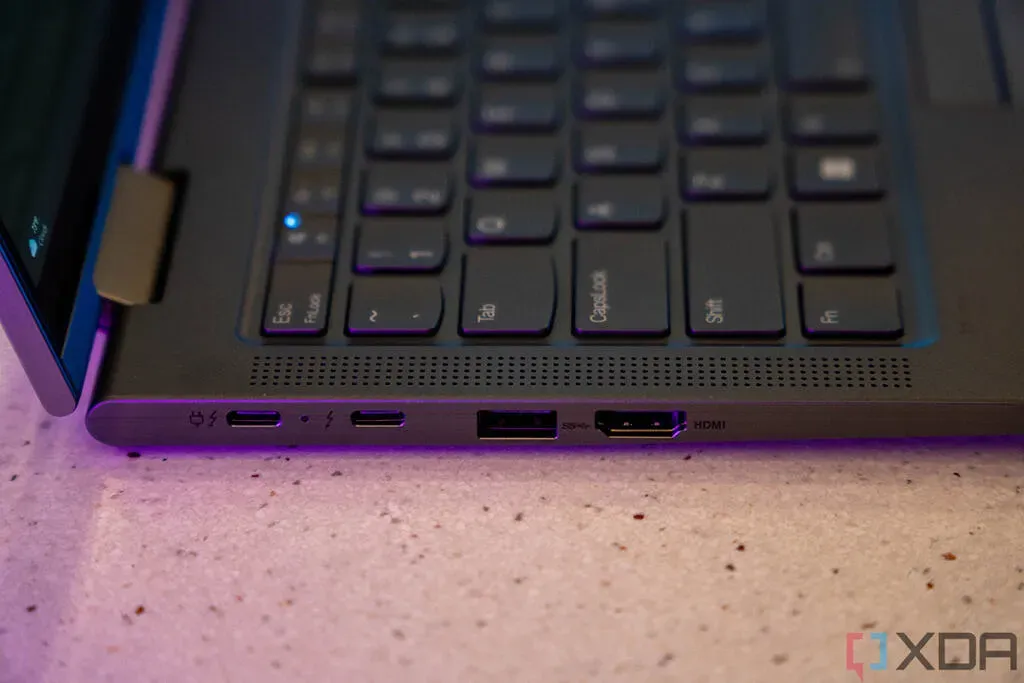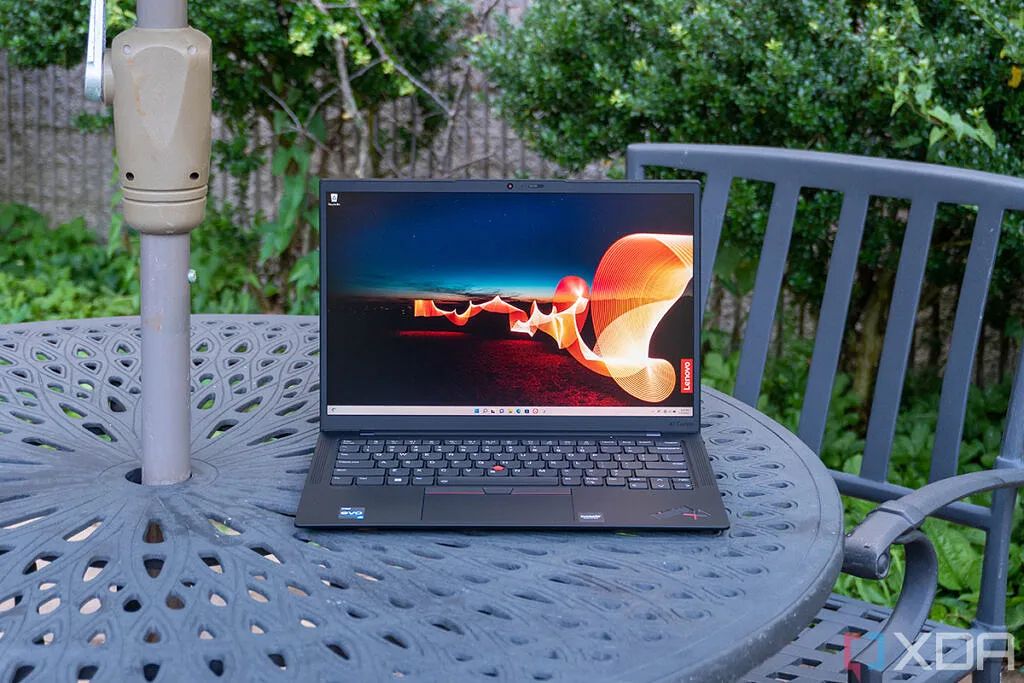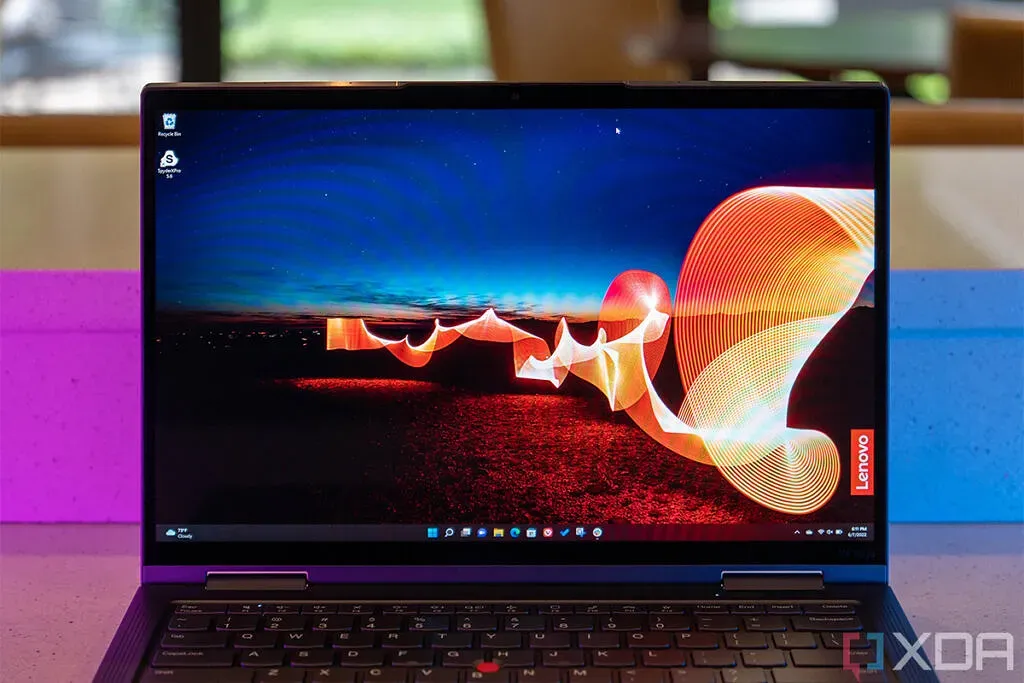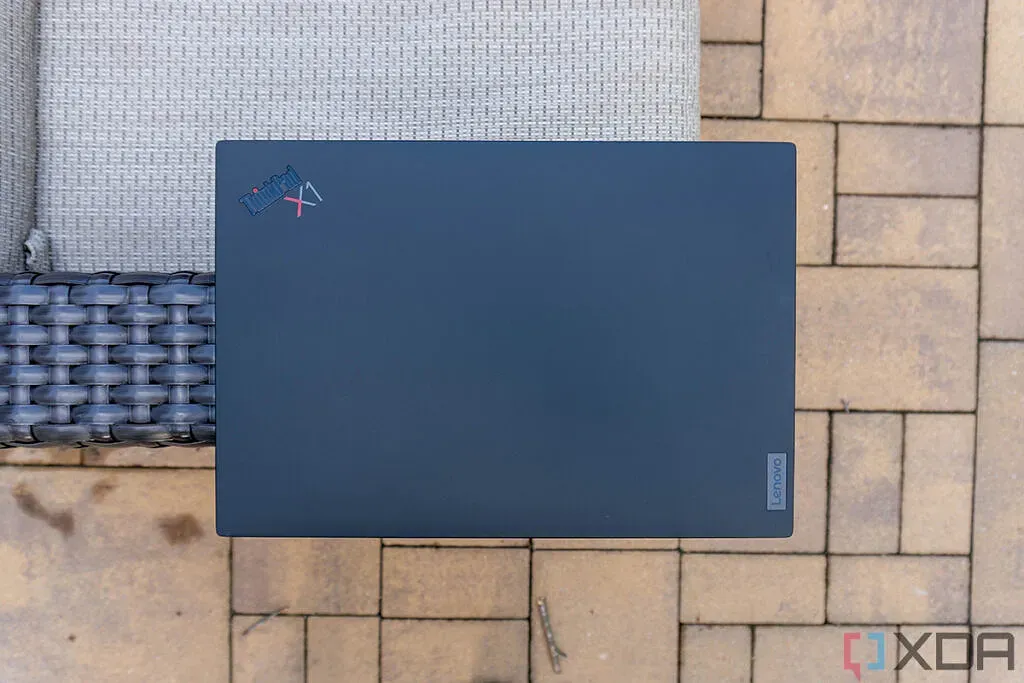-
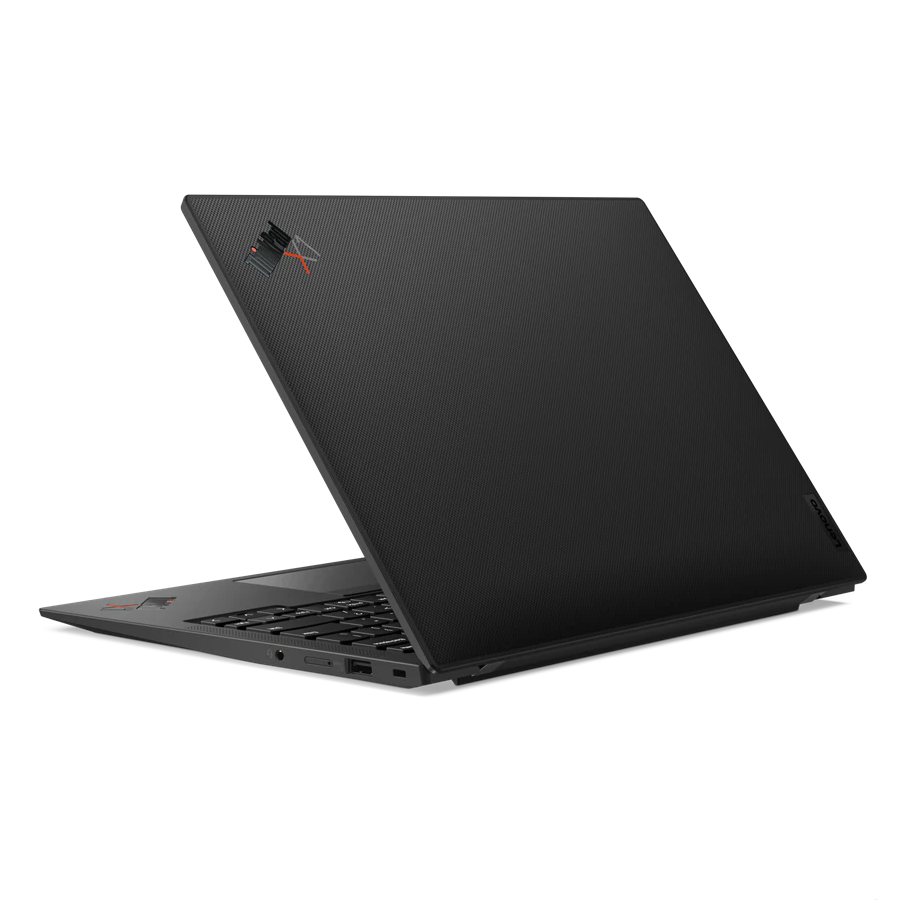
Lenovo ThinkPad X1 Carbon Gen 10
High-end business notebookLenovo's ThinkPad X1 Carbon (Gen 10) is a clamshell business laptop with many high-end features and security measures. It's available with 12th Gen Intel Core U- and P-series CPUs, there are a bunch of displays available, and the keyboard is one of the best around.
Pros- Tons of display options
- Optional 5G and 4G LTE
- Many security features
Cons- No convertible versatility
- No inking
-
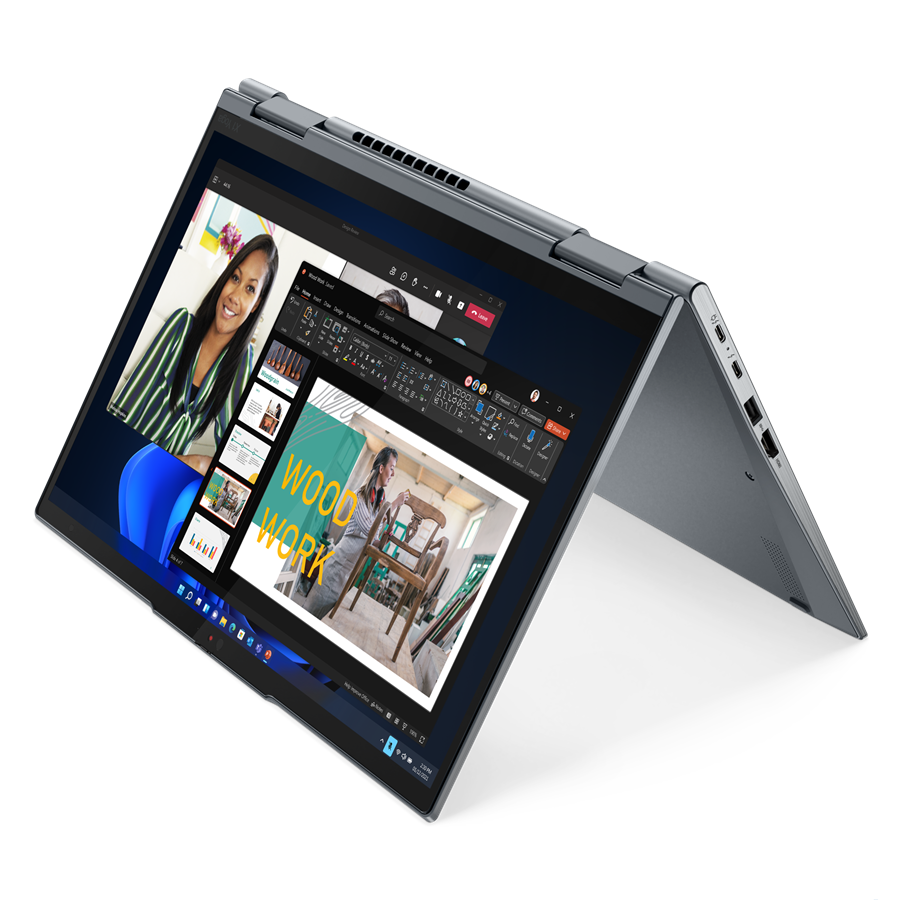
Lenovo ThinkPad X1 Yoga Gen 7
High-end business convertibleThe ThinkPad X1 Yoga (Gen 7) is a convertible business laptop that shares plenty of hardware and features with the X1 Carbon. If you'd like a laptop with a lid that rotates around 360 degrees and can handle inking with a built-in pen, this is the way to go.
Pros- Touch display and built-in active pen
- Strong performance to match the X1 Carbon
- Many security features, optional 5G/4G LTE connectivity
Cons- Fewer display options
- Heavier than the X1 Carbon
Lenovo's ThinkPad X1 series of laptops represents the company's most premium offering of business PCs, and there are a number of different X1 laptops available that we've included in our collection of the overall best Lenovo laptops. The ThinkPad X1 Carbon (Gen 10) is a 14-inch clamshell PC with 12th Gen Intel Core processors (CPU), high-end features, and security measures, while the seventh-gen ThinkPad X1 Yoga is a comparable convertible for those who enjoy the added flexibility and inking capabilities. These laptops start at a similar price and offer much of the same hardware, which can make it difficult to choose one or the other. We've put together this in-depth comparison to help you get the right laptop.
Price, availability, and specs
The best place to shop for these laptops is at the official Lenovo website. There you'll find many different configuration options as well as the ability to build a laptop to your exact specifications. Other major retailers like Amazon, Best Buy, B&H, and Newegg commonly have these laptops for sale, though there you won't have nearly as many configuration options.
Looking at Lenovo's official site, the ThinkPad X1 Carbon (Gen 10) starts at about $1,250 at the time of writing. That's with a fairly significant discount from the regular $2,909 price, but it's expected since the X1 Carbon (Gen 11) is now on the market. That introductory price lands you a 12th-gen Intel Core i5-1240P processor (CPU), 16GB of RAM, a 512GB M.2 SSD, and a 14-inch FHD+ non-touch display.
The ThinkPad X1 Yoga (Gen 7) currently starts at about $1,162 at Lenovo, again discounted due to the new X1 Yoga (Gen 8) hitting the market. The introductory model includes an Intel Core i5-1235U CPU, 8GB of RAM, 256GB M.2 SSD, and FHD+ touch display with anti-reflective finish and integrated active pen. Prices climb from here for both laptops, and you can expect to pay upwards of $4,000 for a maxed-out model when not on sale. These are high-end laptops and have a price to match.
It's important to note also that Lenovo has now released updated versions of these laptops. I reviewed the ThinkPad X1 Carbon (Gen 11) and I reviewed the ThinkPad X1 Yoga (Gen 8), noting in both cases that Lenovo is somehow still finding ways to improve on these awesome PCs. We have a separate ThinkPad X1 Carbon (Gen 11) vs. ThinkPad X1 Yoga (Gen 8) comparison for those more interested in the newer hardware.
Turning back to the older Gen 10 and Gen 7 models, let's take a closer look at the specs available in each laptop.
-
Lenovo ThinkPad X1 Carbon Gen 10 Lenovo ThinkPad X1 Yoga Gen 7 Storage 256GB, 512GB, 1TB, 2TB M.2 PCIe 4.0 NVMe SSD 256GB, 512GB, 1TB, 2TB M.2 PCIe 4.0 NVMe SSD CPU 12th Gen Intel, Core i5-1235U, Core i5-1245U vPro, Core i7-1255U, Core i7-1265U vPro, Core i5-1240P, Core i5-1250P vPro, Core i7-1260P, Core i7-1270P vPro, Core i7-1280P vPro 12th Gen Intel, Core i5-1235U, Core i5-124U vPro, Core i7-1255U, Core i7-1265U vPro, Core i5-1240P, Core i5-1250P vPro, Core i7-1260P, Core i7-1270P vPro, Core i7-1280P vPro Memory 8GB, 16GB, 32GB LPDDR5-5200MHz 8GB, 16GB, 32GB LPDDR5-5200MHz Battery 57Wh 57Wh Ports Two Thunderbolt 4, two USB-A 3.2 (Gen 1), HDMI, 3.5mm audio combo, Nano SIM (optional) Two Thunderbolt 4, two USB-A 3.2 (Gen 1), HDMI, 3.5mm audio combo, Nano SIM (optional) Camera 720p, 1080p, IR, privacy shutter, Computer Vision 1080p, IR, privacy shutter, Computer Vision Display (Size, Resolution) 14 inches, 16:10 aspect ratio, FHD+, 2.2K, 2.8K, UHD+ 14 inches, 16:10 aspect ratio, touch, inking, FHD+, UHD+ Weight From 2.48 pounds (1.12kg) From 3.04 pounds (1.38kg) GPU Intel Iris Xe (integrated) Intel Iris Xe (integrated) Network Wi-Fi 6, Wi-Fi 6E, Bluetooth 5.1, 5G/4G LTE (optional) Wi-Fi 6, Wi-Fi 6E, Bluetooth 5.1, 5G/4G LTE (optional) Speakers Dual 2W woofers, dual 0.8W tweeters, Dolby Atmos Dual 2W woofers, dual 0.8W tweeters, Dolby Atmos
Design and features
The ThinkPad X1 Yoga (Gen 7) has an all-aluminum build with 360 degree hinges that allow the lid to rotate around 360 degrees for tent, stand, and tablet modes. This adds a lot of versatility, especially when you factor in the included active pen that's housed on the side of the chassis in a dedicated silo. The X1 Yoga's convertible build and full aluminum chassis makes it a bit heavier than the X1 Carbon and its carbon fiber lid, but it's still a slim and relatively lightweight laptop. It's available in a Storm grey color, which is a bit of a departure from the usual ThinkPad finish.
The ThinkPad X1 Carbon (Gen 10) has that traditional Deep black color for its clamshell build, with soft-touch paint that does pick up a lot more fingerprints and smudges. Its lid folds back 180 degrees to lie flat, but it doesn't rotate around 360 degrees like the X1 Yoga. It also doesn't feature the same built-in active pen due to its displays not supporting inking. It's thin, it's sleek, and it weighs about a half-pound less than the X1 Yoga.
Port selection is the same across laptops. There are two Thunderbolt 4, two USB-A 3.2 (Gen 1), HDMI, 3.5mm audio combination jack, and an optional Nano SIM slot for those who go with mobile connectivity. This variety should allow you to operate with fewer adapters and dongles, and you can set up a powerful and more permanent workstation with a great Thunderbolt dock. The ThinkPad X1 Yoga has a silo on the right side for its active pen; this keeps it charged up at all times, ready to go when you need to jot down a note or sketch a diagram. ThinkPads generally come with extra durability assurances for busy professional, and that's no different here with MIL-STD 810H certification.
Both laptops are available with Wi-Fi 6 or Wi-Fi 6E (as an upgrade), as well as Bluetooth 5.1. You can also get 4G LTE/5G connectivity as an add-on feature, making either laptop perfect for anyone who needs to stay connected everywhere.
ThinkPad keyboards are some of the best around, and you're going to get an exceptional typing experience with either laptop. The keys are slightly cupped, they're spaced perfectly, and they have relatively deep travel that remains comfortable even during long days of typing. I've typed thousands of words on ThinkPad keyboards and still prefer them over anything else. In his Lenovo ThinkPad X1 Carbon (Gen 10) review, Editor-in-Chief Rich Woods notes that "ThinkPads still offer the Cadillac of keyboards."
Ultimately, these are both high-end laptops with a gorgeous, durable design and plenty of features. The X1 Carbon is no doubt better for those who like to travel light and don't particularly enjoy convertible builds with inking capabilities. If you do need the extra versatility and can foresee using an active pen for sketching and writing, the X1 Yoga is where you'll want to turn.
Audio and camera
Lenovo has used a similar audio setup for both of these laptops, and you're going to get a great listening experience from either PC. Each laptop has four speakers split between two 2W woofers and two 0.8W tweeters. Two speakers flank the keyboard, while two more live on the bottom of the chassis. Dolby Atmos is included to improve the sound quality whether you're listening to music, talking on a call, or watching a movie. Both laptops also include a quad far-field microphone setup with Dolby Voice to ensure your voice comes through loud and clear in conferences.
There are a number of different camera options available depending on your budget and needs. All have a privacy shutter and fixed focus. The X1 Carbon's most basic camera has a 720p resolution, and you can step up to 1080p for a clearer picture. Next is an FHD + IR hybrid that adds biometric security through Windows Hello. And for the best picture possible, Lenovo offers an FHD + IR discrete setup that separates the two cameras for a better RGB picture. This version also adds Lenovo's Computer Vision, which essentially mixes human presence detection and Mirametrix Glance to give you automatic lock and unlock capabilities and a dimming feature.
The X1 Yoga (Gen 7) has the same camera setup options, though there's no option for the 720p camera. It won't be missed by many, and we recommend most people pick up one of the 1080p options anyway for the better picture quality.
Display and inking
The convertible X1 Yoga (Gen 7)'s 14-inch displays all come with a 16:10 aspect ratio, touch functionality, and inking support for the built-in active pen that comes with each laptop. There are four displays available to help you get what you need. The most affordable has a 1920x1200 (FHD+) resolution, anti-glare finish, 400 nits brightness, 100% sRGB color, low power draw, and Eyesafe certification. This same displays is also available with an anti-reflective finish to cut down on glare while still offering a bit of gloss.
An FHD+ model with 500 nits, anti-glare finish, 100% sRGB color, and Lenovo's Privacy Guard feature is great for those who often work in public and don't want anyone looking over their shoulder. When the feature is enabled, it effectively cuts down significantly on the clear viewing angle so that only someone looking directly at it can see. Finally, there's a 3840x2400 (UHD+) resolution option with OLED panel, up to 500 nits brightness with HDR enabled, anti-reflective finish, 100% DCI-P3 color, Dolby Vision, DisplayHDR 400, Eyesafe certification, and low power draw. It's the right choice for those who want the best color possible, but it's also the most expensive.
The clamshell ThinkPad X1 Carbon has a whopping seven different display options listed for this tenth generation. The most affordable has an FHD+ resolution with 400 nits brightness, low power draw, and Eyesafe certification. This is also available in touch, and there's likewise an FHD+ model with Privacy Guard and 500 nits brightness.
Next up is a 2.2K resolution with 300 nits brightness, anti-glare finish, 100% sRGB color, and TÜV Low Blue Light. If that's not quite enough before getting into 4K, Lenovo offers a 2.8K resolution screen with OLED panel, anti-reflective finish, 100% DCI-P3 color, DisplayHDR True Black 500, and Eyesafe certification.
There are two UHD+ displays, one with and one without touch. The non-touch model hits 500 nits brightness, has a glossy finish, 100% DCI-P3 color, Dolby Vision, DisplayHDR 400, and Eyesafe certification. The touch version changes the finish to anti-reflective, but it otherwise has similar specs.
Bottom line? You should be able to get a knockout display whether you go with the X1 Carbon or the X1 Yoga. While the convertible doesn't have as many options, there are still four different screens available with up to that gorgeous UHD+ resolution and OLED panel. With the X1 Yoga you also get inking capabilities with the pen built into the side of the laptop. It offers 4,096 levels of pressure sensitivity and rechargeable battery that gets topped up whenever it's not being used.
Performance, battery, and security
Lenovo makes it easy to compare performance, as it offers the same 12th Gen Intel Core U- and P-series CPUs across the X1 Carbon and X1 Yoga. There are standard and vPro chips available depending on your management needs. Those who need the most performance possible will want to stick with the 28W P-series chips, while those looking to extend battery life and still get a fast system should lean toward the 15W U-series CPUs. Both laptops are available with up to 2TB of M.2 PCIe 4.0 NVMe SSD storage and up to 32GB of LPDDR5-5200MHz RAM. The SSD can be upgraded after purchase, though the RAM is soldered.
We tested the performance of both of these laptops during the review periods, and thanks to our review units having the same Core i7-1260P CPU we can make some quick comparisons. As we can see below, overall system performance through PCMark 10 is about the same, though the Core i7 chip in the X1 Carbon has some extra thermal space on the multi-core end to push numbers. If you're looking to maximize performance, you should be able to eke a bit more out of the non-convertible laptop.
|
ThinkPad X1 Carbon (Gen 10) Core i7-1260P |
ThinkPad X1 Yoga (Gen 7) Core i7-1260P |
|
|---|---|---|
|
PCMark 10 |
5,178 |
5,168 |
|
Geekbench 5 |
1,622 / 8,207 |
1,419 / 6,915 |
|
Cinebench R23 |
1,309 / 7,115 |
1,375 / 6,831 |
|
3DMark Time Spy |
1,761 |
1,458 |
Both laptops have 57Wh batteries, and their ability to last will depend greatly on the display and CPU you choose. In his Lenovo ThinkPad X1 Yoga (Gen 7) review, Editor-in-Chief Rich Woods managed to get more than six hours of regular use on a system using a Core i7-1260P CPU and OLED display. Babying the battery and having a lower-res display and less powerful CPU will easily have your ThinkPad lasting through a full workday without needing a charge.
As for security, both laptops are equipped to better protect your data than a standard laptop. Both have a dTPM 2.0 chip, Kensington Nano lock slot, fingerprint reader, optional IR camera, webcam pivacy shutter, Mirametrix Glance, and the optional Computer Vision with human presence detection. Both laptops also have a number of BIOS-level security measures to keep your laptop protected from the ground up.
Choosing a notebook or a convertible laptop
Considering all the similarities between these two awesome laptops (not to mention the similar pricing model), your choice will likely come down to whether or not you want a clamshell or a convertible build. The X1 Carbon (Gen 10) isn't as versatile as the convertible X1 Yoga, but it is lighter and has a more traditional ThinkPad look with dark soft-touch finish. If you don't foresee a lot of inking with an active pen and don't often feel the need to use your laptop as a tablet, it should be the first choice.

Lenovo ThinkPad X1 Carbon Gen 10
The ThinkPad X1 Carbon (Gen 10) is a sleek business laptop with a clamshell design. If you don't need the convertible aspect of the X1 Yoga, it should be your first choice.
On the other hand, those who love the idea of using a laptop as a tablet some of the time should lean toward the X1 Yoga. The built-in active pen is super handy to have, the silver chassis finish picks up fewer fingerprints (ideal for a tablet that gets handles more often), and you still get a slim and sleek build.

Lenovo ThinkPad X1 Yoga Gen 7
Love the ThinkPad series and want a high-end convertible? The X1 Yoga (Gen 7) has it all, including a built-in active pen and touch displays with inking support.

